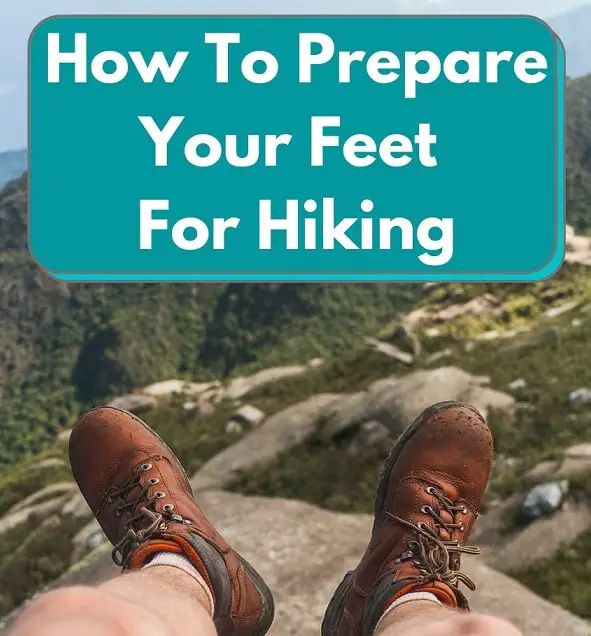Ask any avid hiker and they’ll tell you: nothing’s worse than having blistered or sore feet while out on the trail. As such, it’s important to know how to prepare your feet for hiking to ensure you’re not dealing with foot pain or blisters.
In this guide, we’ll walk through 18 different ways on how to prepare your feet for hiking as well as some additional ways to provide your feet relief once you’re on the trail.
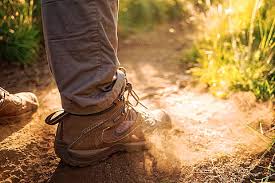
How To Prepare Feet For Hiking
As the saying goes, preparation is everything – as such, making sure you prepare your feet for hiking is critically important.
Check out these different methods below to make sure your feet are trail ready.
Wear Proper Hiking Footwear
Trying to use inappropriate footwear for hiking is like using a tennis racket to play baseball – it’s not going to work well, and someone might get hurt.
Invest in a pair of good hiking boots that fit your feet well and support your ankles.
Check out our reviews of the best men’s hiking boots under $100 and the best women’s hiking boots under $100 for some great suggestions.
Also check out our guide to how hiking boots should fit to make sure your hiking boots match your feet perfectly.
Be Wary Of Waterproof Footwear
Look, we’re a big proponent of waterproof footwear when it’s needed.
If you plan on crossing streams, rivers, or if there’s a high chance you’ll encounter rainy weather or snow on your hike, then you should probably pick waterproof hiking shoes or waterproof hiking boots.
On the other hand, hiking boots with no membrane and breathable upper materials are going to dry much faster if they happen to get wet.
Also, the likelihood of your boots actually getting wet if you primarily stick to dry day hiking is slim to none in the first place.
Moisture softens your skin and makes it easier for blisters to form, so breathable footwear is critical.
Break In Your Hiking Boots
Be sure your hiking boots are properly broken in before going on longer hikes.
Hiking boots require a breaking-in period and going through this process helps the boots form to your feet, so it’s important to not skip this step (unless you love blisters).
Check out our guides on how to break in hiking boots and how to stretch out hiking boots for helpful tips.
Prepare Your Feet For Hiking By Strengthen Your Feet
Doing foot-specific exercises like heel raises, toe raises, toe stretches, and toe splays are great ways to stretch and strengthen your feet which will go a long way in preparing your feet for hiking.
Go Barefoot
Walking barefoot in your yard or on sand is a great way to strengthen and stretch your feet and calves, and it also helps to toughen your skin which helps prevent blisters.
You can gradually increase the length of time or roughness of the terrain you walk barefoot on to further these benefits.
Stretch Your Feet
Stretching the muscles in your feet helps keep them strong, flexible, and promotes a wider range of motion in your joints.
Stretch them every way possible and also take time to stretch your ankles and calves as well before a hike to reduce pain and the risk of injury.
Stop And Adjust Your Laces
Your hiking boot laces can loosen as you hike which can change the fit of your boots, causing extra friction and hot spots.
Pay attention to this and stop as necessary to re-lace your boots to ensure a snug and proper fit.
Build Up Your Skin’s Toughness
Spend a few weeks prior to each hiking season building up the resistance of your feet.
Walk or hike while wearing a light daypack until you start to feel a hot spot in your hiking boots, and stop as soon as you feel a blister forming.
Increase your walking or hiking distance and pack weight over time to build your feet up and prepare your feet for hiking.
Put On Some Thin Socks
Although the comfy and warm properties of thick socks can be alluring, they can also retain moisture and increase sweating which increases the chance of blisters forming.
The use of thin hiking socks will reduce the chances of moisture and blisters while also toughening the skin on your feet.
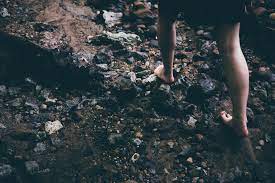
Get Rid Of Blisters Right Away
If you do get a blister, lance it as soon as you can. After draining the fluid, dress it with Moleskin or another type of treatment to prevent the blister from getting worse.
Air Your Feet Out
Taking time to air dry your feet (and socks!) will reduce moisture and friction which reduces your chances of getting blisters on the trail.
By the same token, always start your hike with dry socks and dry hiking boots whenever possible.
Go Easy On The Foot Powder
Although foot powder is great for absorbing moisture, the clumps formed by foot powder can form friction points, leading to blisters.
Use it sparingly or better yet just go for thin hiking socks and boots with breathable materials to cut down on moisture.
Pack Extra Socks
Always include one pair of extra hiking socks in your daypack to make sure your feet stay as dry as possible.
Dirt and debris can get trapped in your socks, leading to irritation.
Consider Trying Out Toe Socks
Toe socks separate your toes and keep them from rubbing together, so that skin-on-skin friction is eliminated which helps protect your feet from hot spots and blisters.
Look for toe socks that are made from moisture-wicking materials.
Pre-Tape Your Feet
If you have hot spots that you know are going to cause issues, take matters into your own hands and tape those spots before hitting the trail.
Moleskin or Leukotape are great choices for taping your feet.
Give Your Feet A Ball Massage
Rolling your feet on a lacrosse ball, golf ball, or a cork ball like the ones from Rawlogy is a great way to reduce foot inflammation and pain after a long day on the trail.
Make Your Skin More Resistant
There’s a household remedy to make the skin on your feet more resistant without drying it out you may consider trying.
Massage your feet on alternating days, one day with lemon juice, the other with moisturizer.
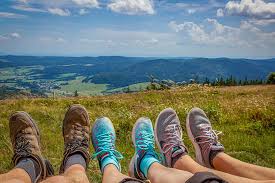
How To Take Care Of Your Feet When Hiking
Now that we’ve covered all the ways on how to prepare your feet for hiking, let’s shift our focus to taking care of those feet while you’re out on the trail.
Watch Out For Hot Spots
If you feel a hot spot, it’s best to call time out and deal with the issue head on by taping it (try Moleskin or Leukotape), or applying some foot balm such as Trail Toes lubricant.
You don’t want to ignore a hot spot- that’s a clear warning sign that a blister is getting ready to form!
Remove Foreign Objects Immediately
Don’t wait to remove grit, sticks, pine needles, or rocks from your shoe.
It’s best to immediately get it out of there because foreign objects aren’t only annoying, they can also cause pain.
Consider wearing light gaiters with your hiking boots to prevent debris and other items from getting in there in the first place.
Take Elevated Breaks
Elevating your feet while sitting or lying down improves circulation and reduces swelling while also draining excess fluid buildup and helps return blood back to your heart.
In addition to these benefits, elevation also helps prevent blisters, mitigate foot pain, and reduce your chances of hiking injury.
Try to elevate your feet whenever you take a break on the trail.
Keep Your Feet Clean
If you’re on a longer hike such as a multi-day backpacking or hiking jaunt, rinse your feet when you have the opportunity.
Keeping dirt, dust, and grime off your feet will reduce friction and sweating.
Be sure to only rinse your feet downstream in a natural water source such as a stream or creek, and don’t use soap in natural water sources.
Change Out Your Socks
On longer hikes you should take the time to stop and change out your socks to reduce moisture and keep your feet dry and comfortable.
If needed, you can rinse out your old socks and pin them to the outside of your backpack using a large safety pin like a diaper pin so they can dry as you hike.
Make sure to turn them inside out when rinsing them to ensure you get all the dirt and grime out of them and get them properly clean!
Give Your Feet A Cold Soak
Soaking your feet in cold water is a great way to relieve swollen or fatigued feet out on the trail.
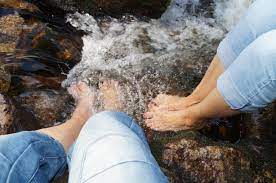
How To Prepare Feet For Hiking – FAQs
Most hikers report it takes between 2 and 4 weeks for calluses to form, although there’s no exact time frame for toughening skin and varies by individual and activity.
Friction is what causes calluses to develop on our feet, and calluses are our skin’s natural response to protect us from uneven ground and natural conditions like heat and cold.
You can develop calluses by introducing friction gradually on your feet by walking barefoot in sand or on rough terrain, increasing the time and roughness of the terrain gradually to avoid injury or blisters.
The dead skin cells create a thick layer at friction points on skin because new skin cells grow faster than dead skin cells can fall off.
Calluses are great for hiking and are actively pursued by many hikers.
Considering that calluses are anywhere from an extra 25 to 100 layers of skin, that is some serious levels of natural protection!
You can develop calluses by introducing friction gradually on your feet by walking barefoot in sand or on rough terrain, increasing the time and roughness of the terrain gradually to avoid injury or blisters.
You can break in hiking boots a variety of ways, but the most common is to start wearing them around the house and for short walks and increasing the distance you walk in them over time until you build up the distance to closely match the length of your intended hikes.
Read our guide on how to break in hiking boots for a deep dive on the topic and some proven methods.
If your hiking boots hurt, it is likely due to not breaking them in properly.
If you’ve owned them for a while and feel that they’re broken in well then it could just be a matter of a poor fit in general.
Take a read through our guide on how should hiking boots fit to get a better understanding of what a good-fitting hiking boot should feel like.
If your boots hurt after being broken in, you may have flat feet. If so, check out our guide to the best hiking boots for flat feet.

